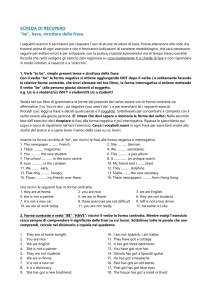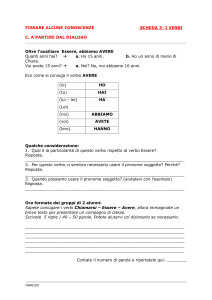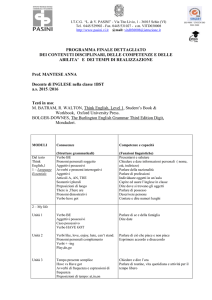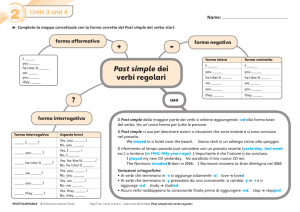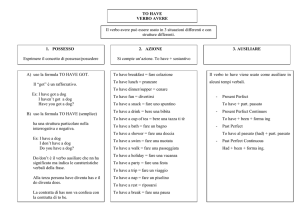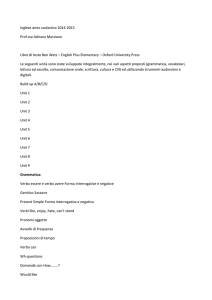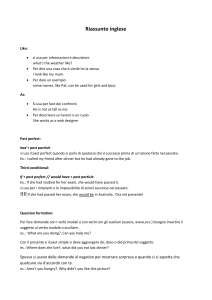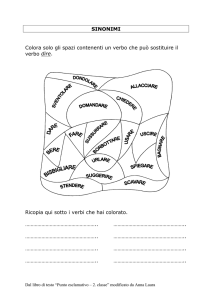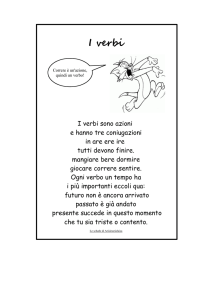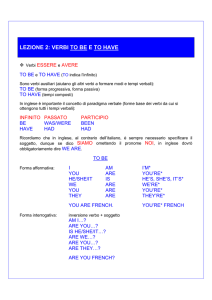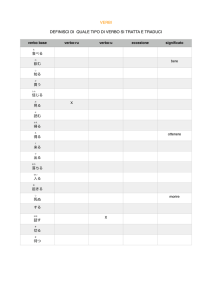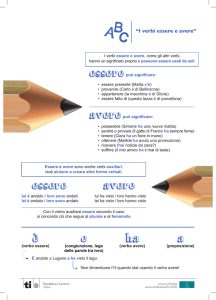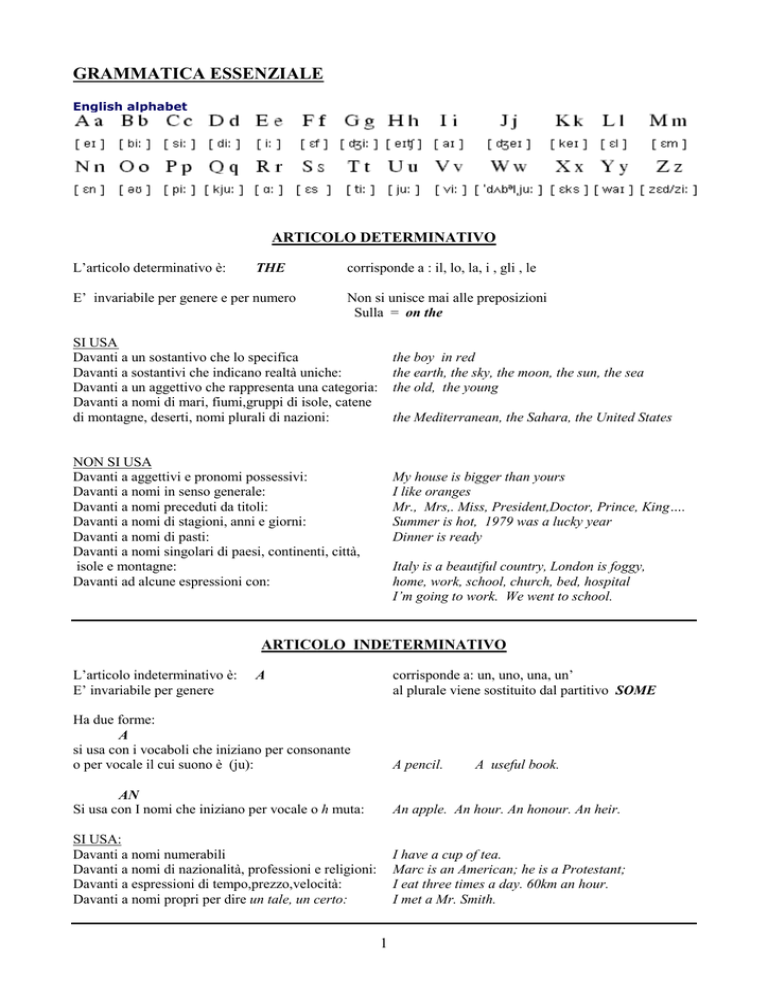
GRAMMATICA ESSENZIALE
English alphabet
ARTICOLO DETERMINATIVO
L’articolo determinativo è:
THE
E’ invariabile per genere e per numero
corrisponde a : il, lo, la, i , gli , le
Non si unisce mai alle preposizioni
Sulla = on the
SI USA
Davanti a un sostantivo che lo specifica
Davanti a sostantivi che indicano realtà uniche:
Davanti a un aggettivo che rappresenta una categoria:
Davanti a nomi di mari, fiumi,gruppi di isole, catene
di montagne, deserti, nomi plurali di nazioni:
the boy in red
the earth, the sky, the moon, the sun, the sea
the old, the young
the Mediterranean, the Sahara, the United States
NON SI USA
Davanti a aggettivi e pronomi possessivi:
Davanti a nomi in senso generale:
Davanti a nomi preceduti da titoli:
Davanti a nomi di stagioni, anni e giorni:
Davanti a nomi di pasti:
Davanti a nomi singolari di paesi, continenti, città,
isole e montagne:
Davanti ad alcune espressioni con:
My house is bigger than yours
I like oranges
Mr., Mrs,. Miss, President,Doctor, Prince, King….
Summer is hot, 1979 was a lucky year
Dinner is ready
Italy is a beautiful country, London is foggy,
home, work, school, church, bed, hospital
I’m going to work. We went to school.
ARTICOLO INDETERMINATIVO
L’articolo indeterminativo è:
E’ invariabile per genere
A
corrisponde a: un, uno, una, un’
al plurale viene sostituito dal partitivo SOME
Ha due forme:
A
si usa con i vocaboli che iniziano per consonante
o per vocale il cui suono è (ju):
A pencil.
AN
Si usa con I nomi che iniziano per vocale o h muta:
An apple. An hour. An honour. An heir.
SI USA:
Davanti a nomi numerabili
Davanti a nomi di nazionalità, professioni e religioni:
Davanti a espressioni di tempo,prezzo,velocità:
Davanti a nomi propri per dire un tale, un certo:
I have a cup of tea.
Marc is an American; he is a Protestant;
I eat three times a day. 60km an hour.
I met a Mr. Smith.
1
A useful book.
PRONOMI PERSONALI
1° sing.
2° sing.
3° sing. masch.
femm.
neutro
1° plu.
2° plu.
3° plu.
-
SOGGETTO
COMPLEMENTO
I
you
he
she
it
we
you
they
me
you
him
her
it
us
you
them
io
tu
egli
ella
esso/essa
noi
voi
essi/esse
me,mi
te,ti
lui, gli, lo
lei, le, la
lo, gli, la, le
noi, ci
voi, vi
loro, li, le
il pronome I si scrive sempre maiusocolo
la terza persona singolare ha 3 generi: he, she, it
la terza persona plurale è uguale per i 3 generi: they
la ns. forma di cortesia Voi e Lei non esiste in inglese. Si usa sempre YOU
i pronomi soggetto non si possono sottointendere e devono dunque precedere il verbo
le particelle pronominali mi, ti, ci, si, vi non esistono e vengono quindi sostituiti dal
corrispondente pronome complemento che seguono sempre il verbo
esempio: we see them
noi li vediamo (noi vediamo loro)
esmpio: give it to him
Daglielo!
(dai esso a lui)
attenzione!
Il pronome “lo” si traduce nel modo seguente:
- him se è maschile
es. I hope to see him spero di vederlo
- it se è neutro
es. I buy it
lo compro
- so accompagnato ai verbi to believe (credere) to hope (sperare)
to suppose(supporre), to think (credere).
Es. We hope so (lo speriamo) I think so (lo credo)
PRONOMI RIFLESSIVI
Oneself
Myself
Yourself
Himself
Herself
Itself
Ourselves
Yourselves
Themselves
sé stesso (indefinito)
mi, me stesso
ti, te stesso
si, lui stesso
si, lei stessa
si, esso stesso
ci, noi stessi
vi, voi stessi
si, loro stessi/e
-Verbo riflessivo + Complemento oggetto(italianao) = agg. possessivo+ complemento (inglese)
Si sta lavando le mani
= He is washing his hands
-Il pronome riflessivo segue il verbo:
Essi si lavano
= They wash themselves
Att.ne:
da solo = by himself
Proprio lei = she herself
2
AGGETTIVI E PRONOMI POSSESSIVI
1° pers.sing.
2° pers.sing.
3° per.sing.masch.
femm.
neutro
1° pers.plurale
2° pers.plurale
3° pers.plurale
AGGETTIVI
PRONOMI
my
your
his
her
its
our
your
their
mine
yours
his
hers
ours
yours
theirs
mio,mia, miei, mie
tuo, tua, tuoi, tue
(di lui) suo, sua, suoi, sue
(di lei) suo, sua, suoi, sue
(di cosa) suo, sua, suoi, sue
nostro,nostra,nostri,nostre
vostro,vostra,vostri,vostre
loro
L’aggettivo possessivo
- è invariabile - rifiuta l’articolo - precede sempre il nome a cui è riferito
- alla terza persona singolare si concorda con il possessore e non con la cosa posseduta
- si usa davanti alle parti del corpo, ai capi di vestiario e ai nomi di parenti
- con own rafforza l’idea di possesso
Il pronome possessivo
- sostituisce il nome
- rifiuta l’articolo
- alla terza persona singolare si concorda con il nome del possessore
- il pronome possessivo preceduto da of sostituisce l’aggettivo possessivo
PRONOMI RECIPROCI
Each other
One another
-
l’un l’altro (fra due)
l’un l’altro (fra tanti)
con i verbi reciproci, le particelle si, ci, vi si traducono
we love each other
noi ci amiamo
the students helped one another
tutti gli studenti si aiutarono
att. Non sempre vi è corrispondenza nei verbi reciproci: si baciarono = they kissed
IL PRONOME IMPERSONALE “SI”
- Nei proverbi: One
- Qundo indica “la gente”: people
- Se indica l’umanità: Man
- Se indica un gruppo di persone: we, you, they
es. one likes to give advice - man is mortal - people eat a lot in Italy – we are tired after that walk –
you must be silent - they read a lot in that family.
3
AGGETTIVI E PRONOMI DIMOSTRATIVI
THIS
questo, questa
THAT
quel, quello, quella
THESE
questi, queste
THOSE
quei,quegli,quelli,quelle
-
sono invariabili per genere ma non per numero
il pronome dimostrativo italiano seguito da un aggettivo si traduce:
the + aggettivo + one (ones)
esempio:
the green one is mine
=
quello verde è mio
Questo…quello (il primo …il secondo) si traduce con the former……….the latter
PARTITIVI
Sono aggettivi e pronomi che indicano un certo numero o una certa quantità di persone o di cose, cioè
corrispondono a : del, della, dei, degli, delle alcuni, alcune, qualche, un po’, nessuno.
1.Nella forma affermativa:
Some (aggettivo e pronome)
2.Nella forma interrogativa o dubitativa
Any (aggettivo e pronome)
3.Nella forma negativa o interro-negativa (con verbo negativo)
Any
4.Nella forma negativa (con verbo positivo o affermativo)
No (agg.) o None (pronome)
esempi
1.
2.
3.
4.
(aggettivo e pronome)
I have got some books. Mark has some, too.
Have you got any books? Have you got any?
Haven’t you got any books? Haven’t you got any? I haven’t got any books. I haven’t got any.
I have no books. I have none.
Attenzione: non si possono usare 2 negazioni nella stessa frase, dunque:
verbo negativo + any
verbo positivo + no
Nelle frasi affermative “any” significa “chiunque” o “qualunque”
Any child loves toys.
PARTITIVI CON AGGETTIVI, PRONOMI O AVVERBI I N D E F I N I T I :
someone, anyone, no one
somebody, anybody, nobody
something, anything, nothing
somewhere, anywhere, nowhere
somehow, anyhow, nohow
someway, anyway, noway
4
AGGETTIVI E PRONOMI INTERROGATIVI
Who
chi?
Solo pronome e solo inerente a persone.
Whose =
di chi? Del quale?
Aggettivo e pronome
What =
che cosa? Quale?
Aggettivo e pronome
Which =
quale? Quali?
Aggettivo e pronome
Es.
=
Who are you?
Whose car is this?
What are you talking about?
Which of these books is yours?
________________________________________
________________________________________
________________________________________
_______________________________________
PRONOMI RELATIVI
Who
Which
That
soggetto
che
Whom
Which
That
complemento
che
Whose
of which
-----
genitivo di possesso
il cui, di cui, il che
Att.
Es.
che
che
“which” si usa per cose, concetti ed animali
“that” può sostituire who, whom, which.
The boy who is playing in the garden is my brother. ______________________________________
The girl whose parents I know is Indian.________________________________________________
This is the man whom I met in London._________________________________________________
The ball which is in the garden is red. __________________________________________________
The woman that I met yesterday is Italian._______________________________________________
AGGETTIVI QUALIFICATIVI
Sono invariabili per genere e per numero.
A nice boy
Nice girls
A nice house
Precedono sempre il nome a cui si riferiscono!
Quando vi sono più aggettivi riferiti allo stesso soggetto, seguono il seguente ordine:
dimensione – qualità - età – forma – colore – origine – materia
Es.
A big, beautiful modern round white French plastic table.
5
COMPARATIVO E SUPERLATIVO
a) DI MAGGIORANZA
1) Con aggettivi monosillabici e bisillabici che terminano in ble, er, ow, y:
comparativo
aggettivo + er than
superlativo
the + aggettivo + est of
Mark is taller than Bob.
Mark è più alto di Bob.
John is the tallest of all.
John è il più alto di tutti.
2) Con aggettivi bisillabici e polisillabici che terminano in al, ed, ful, ile, ive, less:
comparativo
more + aggettivo + than
superlativo
the most + aggettivo + of/in
Mary is more beautiful than Jane.
Mary è più bella di Jane.
Rose is the most beautiful of all.
Rose è la più bella di tutte.
b) DI UGUAGLIANZA
As + aggettivo + as
Rose is as pretty as Anne.
Rose è bella quanto Anne.
c) DI MINORANZA
1)Con aggettivi o sostantivi singolari:
comparativo
less + aggettivo + than
superlativo
the least + aggettivo + of
I am less patient than you.
Sono meno paziente di te.
Bob is the least patient of all.
Bob è il meno paziente di tutti.
I have less talent than you.
Ho meno talento di te.
2) Con sostantivi plurali:
fewer +sostantivo+than
I have fewer friends than Mark. Ho meno amici di Mark.
d) SUPERLATIVO ASSOLUTO
Si forma semplicemente anteponendo very (molto) all’aggettivo o all’avverbio
This picture is very beautiful
Questo quadro è bellissimo.
I like it very much.
Mi piace tantissimo.
6
SOSTANTIVI
I sostantivi in inglese sono di tre generi:
maschile
Femminile
Neutro
Sono spesso femminili i nomi di navi, i nomi di automobili o altri mezzi in relazione a chi li guida e i nomi di
paesi considerati politicamente.
La maggior parte dei nomi ha una sola forma per il maschile e femminile:
cousin ( cugino/cugina)
cook (cuoco/cuoca)
Alcuni nomi hanno due forme diverse: nephew (nipote maschio)
niece
(nipote femmina)
Count
(conte)
countess
(contessa)
Hero
(eroe)
heroine
(eroina)
NOMI COMPOSTI
Con due sostantivi di cui il primo specifica il secondo e assume tutte le caratteristiche dell’aggettivo.
The morning paper
A gold ring
il giornale del mattino
un anello d’oro
Con un participio presente ed un sostantivo
A reading lamp
A waiting hall
una lampada per la lettura
una sala d’attesa
Att.ne: a wine glass = un bicchiere da vino
a glass of wine = un bicchiere di vino.
IL PLURALE DEI SOSTANTIVI
Si forma aggiungendo “s” al singolare: dog
cane
dogs
cani
PARTICOLARITA’ ed ECCEZIONI
- I nomi che al singolare terminano in s, ss, sh, ch, x, z, o : prendono “es”
watch orologio
watches
orologi
box
scatola
boxes
scatole
- I nomi che terminano in y preceduta da vocale ottengono “s”:
boy
I nomi che terminano in y preceduta da consonante trasformano la y in ie+s: party
boys
parties
- I nomi che al singolare terminano in f o fe ottengono la desinenza ves:
shelves
- Alcuni sostantivi fanno il plurale in modo irregolare:
man
men
uomo, uomini
woman
women
donna, donne
child
children
bambino, bambini
foot
feet
piede, piedi
mouse
mice
topo, topi
- Alcuni sostantivi hanno solo la forma singolare:
advice, business, forniture, hair, information, luggage, news…
- Alcuni sostantivi hanno solo forma plurale:
goods, people
7
shelf
GENITIVO SASSONE
Il genitivo sassone o possessive case si usa per indicare l’idea del possesso.
Di regola, il possessore deve essere persona o essere animanto. La regola è:
possessore + ‘s + cosa o persona posseduta
es.
My mother’s car
Bob’s bike
L’automobile di mia madre
La bicicletta di Bob
- se il possessore è un plurale che termina in “s”, si mette solo l’apostrofo:
The pupils’ books are new
I libri degli scolari sono nuovi
- se il possessore è un nome singolare che termina in s, ss, sh,ch,x, z si aggiunge comunque la s :
The princess’s crown
La corona della principessa
- se i possessori sono diversi ma la cosa posseduta è in comune, si mette il genitivo sassone
dopo l’ultimo possessore nominato:
Bob and Mary’s parents
I genitori di Bob e Mary
- se i possessori sono diversi ed il possesso è individuale, ogni possessore ottiene il genitivo sassone:
Bob’s and Mary’s clothes are in the white wardrobe
Gli abiti di Bob e di Mary sono nell’armadio bianco
- dopo un genitivo sassone si possono sottintendere espressioni di luogo inerenti a casa, chiesa, ufficio
negozio, ambulatorio:
We are at Mark’s (home)
Siamo a casa di Mark
I go to the baker’s (shop)
Vado dal fornaio
Casi in cui il genitivo sassone si attribuisce a possessore che non è persona o cosa animata:
yesterday’s newspaper, two miles’ walk, London’s beauty, Italy’s art,
8
E' importante poter riconoscere e identificare le diverse parti del discorso in Inglese così
da poter comprendere le spiegazioni grammaticali e usare la forma giusta della parola nel
posto giusto. Ecco una breve spiegazione di quello che sono le parti del discorso.
SOSTANTIVO (noun)
il sostantivo è una parola che determina una persona,
un luogo, una cosa, un'idea, una creatura vivente, una
qualità, o un'azione. Esempi: cowboy, theatre, box,
thought, kindness, arrival
VERBO (verb)
il verbo è una parola che descrive un'azione (fare
qualcosa) o uno stato (essere qualcosa). Esempi: walk,
talk, think, believe, live, like, want
AGGETTIVO (adjective)
l'aggettivo è una parola che descrive un sostantivo, ci
dice qualcosa del sostantivo. Esempi: big, yellow, thin,
amazing, wonderful, quick, important
AVVERBIO (adverb)
l'avverbio è una parola che di solito descrive un verbo,
ci dice come si fa qualcosa o può dirci quando e dove è
avvenuto qualcosa . Esempi: slowly, intelligently, well,
yesterday, tomorrow, here, everywhere
PRONOME (pronoun)
il pronome è usato al posto di un sostantivo per evitare
di ripeterlo. Esempi: I, you, he, she, it, we, they
CONGIUNZIONE
(conjunction)
la congiunzione unisce due parole, locuzioni o frasi.
Esempi: but, so, and, because, or
PREPOSIZIONE
(preposition)
la preposizione viene di solito prima di un sostantivo,
pronome o locuzione ed unisce il sostantivo a qualche
altra parte della frase. Esempi: on, in, at, by, with,
under, through
l'interiezione, o esclamazione, è un tipo di parola
insolita perché spesso sta da sola ed esprime emozione
INTERIEZIONE (interjection)
o sorpresa ed è seguita di solito dal punto esclamativo.
Esempi: Hello! Oh no! Ouch! Ha!
ARTICOLO (article)
l'articolo viene usato per introdurre un sostantivo.
Esempi: the, a, an
9
VERBO TO BE
Il verbo essere in inglese si traduce con TO BE.
Forma AFFERMATIVA:
Soggetto + TO BE + complemento (Es: Mark is American.)
Forma NEGATIVA:
Soggetto + TO BE + NOT + complemento (Es: Mark is not American.)
Forma INTERROGATIVA:
TO BE + soggetto + complemento (Es: Is Mark American?)
Forma INTERROGATIVA-NEGATIVA: forma contratta di BE/ NOT+ soggetto + complemento
(Es: Isn’t Mark American?).
Simple Present
Forma
per
esteso
Forma
contratta
AFFERMATIVA
NEGATIVA
INTERROGATIVA
INTERROGATIVO-NEGATIVA
I am
I am not
Am I …?
Am I not…?
You are
You are not
Are you…?
Are you not…?
He is
He is not
Is he…?
Is he not…?
She is
She is not
Is she…?
Is she not…?
It is
It is not
Is it…?
Is it not…?
We are
We are not
Are we…?
Are we not…?
You are
You are not
Are you…?
Are you not…?
They are
They are not
Are they…?
Are they not…?
I’m
You’re
I’m not
He’s
She’s
Aren’t I…?
Aren’t you…?
You’re not
You aren’t
Isn’t he…?
Isn’t she…?
He’s not
He isn’t
Isn’t it…?
It’s
She’s not
She isn’t
We’re
It’s not
It isn’t
We’re not
We aren’t
Aren’t we…?
You’re
They’re
Aren’t you…?
You’re not
You aren’t
Aren’t they…?
They’re not
They aren’t
Attenzione! La forma estesa viene usata prevalentemente nella lingua scritta.
La forma contratta di Am I not…? usata nel parlato è Aren’t I…?
10
Simple Past
AFFERMATIVA NEGATIVA
Forma per
esteso
I was
I was not
You were
You were
not
He was
INTERROGATIVA INTERROGATIVONEGATIVA
Was I …?
Was I not…?
Were you…?
Were you not…?
Was he…?
Was he not…?
Was she…?
Was she not…?
Was it…?
Was it not…?
He was not
She was
She was not
It was
It was not
We were
We were not
Were we…?
Were we not…?
You were
You were
not
Were you…?
Were you not…?
Were they…?
Were they not…?
They were
They were
not
Forma
contratta
I wasn’t
Wasn’t I…?
You weren’t
Weren’t you…?
He wasn’t
Wasn’t he…?
She wasn’t
Wasn’t she…?
It wasn’t
We weren’t
Wasn’t it…?
Weren’t we…?
You weren’t
Weren’t you…?
They weren’t
Weren’t they…?
Il Past Participle di TO BE è been (“stato”).
11
VERBO
TO HAVE (GOT)
Il verbo avere in inglese si traduce con TO HAVE e quando è usato con il significato di possedere può
essere seguito dal rafforzativo GOT.
Nelle forme interrogativa, negativa e interro-negativa del Simple Present GOT è sempre richiesto.
Attenzione: quando TO HAVE (GOT) è seguito dalla preposizione TO significa DOVERE.
Forma AFFERMATIVA:
Forma NEGATIVA:
Soggetto + TO HAVE (GOT) + complemento (Es: Mark has (got) a car.)
Soggetto + TO HAVE GOT + NOT + complemento (Es: Mark hasn't got a car.)
Forma INTERROGATIVA: TO HAVE + soggetto + GOT + complemento (Es: Has Mark got a car?)
Forma INTERRO-NEGATIVA: forma contratta di TO HAVE e NOT+ soggetto + GOT + complemento
(Es: Hasn’t Mark got a car?).
Simple Present
Forma per
esteso
Forma
contratta
AFFERMATIVA
NEGATIVA
INTERROGATIVA
I have (got)
I have not got
Have I got …?
You have (got)
You have not got
Have you got …?
He has (got)
He has not got
Has he got …?
She has (got)
She has not got
Has she got …?
It has (got)
It has not got
Has it got …?
We have (got)
We have not got
Have we got …?
You have (got)
You have not got
Have you got …?
They have (got)
They have not got
Have they got …?
I’ve (got)
I haven’t got
You’ve (got)
You haven’t got
He’s (got)
He hasn’t got
She’s (got)
She hasn’t got
It’s (got)
It hasn’t got
We’ve (got)
We haven’t got
You’ve (got)
You haven’t got
They’ve (got)
They haven’t got
12
Simple Past
AFFERMATIVA
La forma con got non si usa al passato.
INTERROGATIVA
NEGATIVA
I had
I didn't have
Did I have…?
You had
You didn't have
Did you have…?
He had
He didn't have
Did he have …?
She had
She didn't have
Did she have…?
It had
It didn't have
Did it have …?
We had
We didn't have
Did we have …?
You had
You didn't have
Did you have …?
They had
They didn't have
Did they have…?
Il Past Participle di TO HAVE è had (“avuto”).
Attenzione! Quando TO HAVE viene usato con significati diversi da possedere non usa il rafforzativo GOT e
le forme negativa, interrogativa e interrogativa-negativa si costruiscono con gli ausiliari DO/DOES/DID
Es:
I have a shower every morning
(“Faccio la doccia ogni mattina”)
I don’t have lunch at 12
(“Non pranzo alle 12”)
Does she have breakfast alone?
(“Fa colazione da sola?”)
Did you have a nice flight?
(“Hai fatto un buon volo?”)
13
FORMAZIONE DEL SIMPLE PRESENT
Il Simple Present Tense è uno dei tempi più comuni in inglese. Ci sono solo due forme per
il Simple Present: la forma base e la forma base + s. Ad esempio: sing (cantare)
SOGGETTO
FORMA DEL VERBO
ESEMPIO
I
forma base
I sing
You
forma base
You sing
He
forma base + s
He sings
She
forma base + s
She sings
It
forma base + s
It sings
We
forma base
We sing
You
forma base
You sing
They
forma base
They sing
In altre parole solo la 3° PERSONA SINGOLARE (he, she, it) aggiunge la s alla forma
base.
Con la maggior parte dei verbi, la 3a persona singolare si forma semplicemente
aggiungendo -s. Per alcuni verbi è necessario aggiungere -es. Ecco le regole:
VERBI CHE TERMINANO
IN...
COME FARE LA 3a
PERSONA SINGOLARE
ESEMPI
s
aggiungere -es
He kisses
sh
aggiungere -es
She wishes
ch
aggiungere -es
He watches
x
aggiungere -es
She mixes
z
aggiungere -es
She buzzes
o
aggiungere -es
He goes
consonante + y
cambiare la y in i e aggiungere es
It flies
14
FORME INTERROGATIVA E NEGATIVA DEL SIMPLE PRESENT
Nel Simple Present le frasi negative e interrogative si formano usando l'ausiliare do o does.
FORMA NEGATIVA
La forma negativa del Simple Present si ottiene aggiungendo don't o doesn't prima della forma
base del verbo:
SOGGETTO
AUSILIARE
ESEMPIO
I
don't
I don't work
You
don't
You don't work
He
doesn't
He doesn't work
She
doesn't
She doesn't work
It
doesn't
It doesn't work
We
don't
We don't work
You
don't
You don't work
They
don't
They don't work
Come potete osservare, solo i pronomi di 3a persona singolare (he, she, it) sono seguiti
da doesn't, per tutti gli altri si usa don't.
FORMA INTERROGATIVA
La forma interrogativa del Simple Present si ottiene con l'ausiliare do o does davanti al
soggetto.
AUSILIARE
SOGGETTO
ESEMPIO
Do
I
Do I work?
Do
you
Do you work?
Does
he
Does he work?
Does
she
Does she work?
Does
it
Does it work?
Do
we
Do we work?
Do
you
Do you work?
Do
they
Do they work?
15
FORMAZIONE DEL PRESENT CONTINUOUS TENSE
Il Present Continuous Tense (chiamato anche Present Progressive Tense) è comunemente
usato in inglese per descrivere azioni che si stanno svolgendo in questo preciso momento,
o programmate nel futuro.
FORMAZIONE DEL PRESENT CONTINUOUS
Questo tempo viene formato usando due componenti: il presente semplice del verbo
essere (to be) e la forma -ing del verbo di cui si vuole formare il presente progressivo.
SOGGETTO
VERBO ESSERE
FORMA -ING DEL VERBO
I
am
working
You
are
working
He
is
working
She
is
working
It
is
working
We
are
working
You
are
working
They
are
working
COME CREARE LA FORMA -ING DEI VERBI
Con molti verbi basta aggiungere -ing alla forma base, con altri è necessario cambiare un
po' la parte finale
VERBI CHE TERMINANO
IN...
COME CREARE LA FORMA
-ING
1 vocale + 1 consonante
raddoppiare la consonante e
aggiungere -ing
1 vocale + 1 consonante + e
rimuovere la e, poi aggiungere ing
ESEMPI
swim - swimming
get - getting
come - coming
live - living
go - going
tutti gli altri
aggiungere -ing
say - saying
16
FORME INTERROGATIVA E NEGATIVA DEL PRESENT CONTINUOUS
Nel Present Continuous la forma negativa si fa usando not e quella interrogativa
cambiando l'ordine delle parole della frase.
FORMA NEGATIVA
Le negative sono formate aggiungendo not o n't dopo il verbo essere
FRASE AFFERMATIVA
FRASE NEGATIVA
NEGATIVE CONTRATTE
I am working
I am not working
I'm not working
You are working
You are not working
You aren't working
He is working
He is not working
He isn't working
She is working
She is not working
She isn't working
It is working
It is not working
It isn't working
We are working
We are not working
We aren't working
You are working
You are not working
You aren't working
They are working
They are not working
They aren't working
17
The Present Perfect Tense and the Simple Past Tense
This section will help you to understand the differences between the Present Perfect
Tense and the Simple Past Tense.
The present perfect is used when the time period has
NOT finished:
The simple past is used when the time period HAS
finished:
The present perfect is often used when giving recent
news:
The simple past is used when giving older information:
The present perfect is used when the time is not specific:
The simple past is used when the time is clear:
The present perfect is used with for and since, when the
actions have not finished yet:
The simple past is used with for and since, when the
actions have already finished:
18
I have seen three movies
this week.
(This week has not finished
yet.)
I saw three movies last
week.
(Last week has finished.)
Martin has crashed his
car again.
(This is new information.)
Martin crashed his car
last year.
(This is old information.)
I have seen that movie
already.
(We don't know when.)
I saw that movie on
Thursday.
(We know exactly when.)
I have lived in Victoria
for five years.
(I still live in Victoria.)
I lived in Victoria for five
years.
(I don't live in Victoria now
FORMAZIONE DEL SIMPLE PAST TENSE (VERBI REGOLARI)
Il Simple Past Tense è uno dei tempi più comuni in inglese. La sua forma è la stessa con
tutti i soggetti: per i verbi regolari si aggiunge -ed alla forma base, ad eccezione di pochi
che cambiano un po' la parte finale.
VERBI CHE TERMINANO
IN...
COME COSTRUIRE IL
SIMPLE PAST
e
aggiungere -d
ESEMPIO
live - lived
date - dated
consonante + y
1 vocale + 1 consonante
(ma non w o y)
cambiare y in i, poi aggiungere
-ed
raddoppiare la consonante, poi
aggiungere -ed
try - tried
cry - cried
unzip - unzipped
stop - stopped
fill - filled
boil - boiled
tutti gli altri
aggiungere -ed
work -worked
play -played
19
FORMAZIONE DEL SIMPLE PAST TENSE (VERBI IRREGOLARI)
I tre verbi irregolari più importanti sono be (essere), have (avere) e do (fare)
PRONOME
VERBO ESSERE (be)
VERBO AVERE (have)
VERBO FARE (do)
I
was
had
did
You
were
had
did
He / She / It
was
had
did
We
were
had
did
You
were
had
did
They
were
had
did
Altri verbi irregolari si dividono in 3 principali categorie:
CATEGORIA
ESEMPI
verbi che non cambiano
cut - cut
verbi che cambiano la loro vocale
get - got
verbi che cambiano completamente
hit - hit
sit - sat
catch - caught
fit - fit
cost - cost
drink - drank come - came
go - went
bring - brought
FORME INTERROGATIVA E NEGATIVA DEL SIMPLE PAST TENSE
La frase negativa e interrogativa del Simple Past si forma con l'ausiliare did seguito dalla
forma base del verbo principale.
FORMA NEGATIVA
Le negative del Simple Past sono formate aggiungendo didn't (informale) o did not
(formale) davanti alla forma base del verbo. Il verbo essere fa eccezione, infatti è
necessario aggiungere n't (informale) o not (formale) dopo was o were.
FRASE AFFERMATIVA
NEGATIVA INFORMALE
NEGATIVA FORMALE
I had a car
I didn't have a car
I did not have a car
You drank my beer
You didn't drink my beer
You did not drink my beer
He was here yesterday
He wasn't here yesterday
He was not here yesterday
They were in the park
They weren't in the park
They were not in the park
20
FORMAZIONE DEL PRESENT PERFECT TENSE
Il Present Perfect si forma con l'ausiliare have al presente più il participio passato del verbo principale. Se il
verbo è regolare il participio passato (Past Participle) si forma aggiungendo -ed alla forma base. Alcuni verbi
formano il participio passato in modo irregolare. In questo schema vengono presentati il verbo regolare
walk e quello irregolare eat.
SOGGETTO
HAVE
PARTICIPIO PASSATO
I
have
walked
/
eaten
You
have
walked
/
eaten
He
has
walked
/
eaten
She
has
walked
/
eaten
It
has
walked
/
eaten
We
have
walked
/
eaten
You
have
walked
/
eaten
They
have
walked
/
eaten
Nota che il soggetto e l'ausiliare possono essere contratti
I've
walked
/
eaten
You've
walked
/
eaten
He's
walked
/
eaten
She's
walked
/
eaten
It's
walked
/
eaten
We've
walked
/
eaten
You've
walked
/
eaten
They've
walked
/
eaten
Con i verbi regolari il participio passato si forma allo stesso modo del Simple Past, e cioè
aggiungendo -ed alla fine del verbo, vedi FORMAZIONE DEL SIMPLE PAST TENSE
(VERBI REGOLARI). Per i verbi irregolari esistono molti modi per formarne il participio
passato. Eccone qualche esempio
CATEGORIA
verbi che non cambiano
verbi che cambiano la
vocale
Present
cut
sit
hit
Simple Past
fit
cut
sing drink
verbi che aggiungono en
break eat take
verbi che cambiano
completamente
catch bring teach
sat
hit
fit
sang drank
broke ate took
Past Participle
cut
hit
fit
sat sung drunk
broken eaten taken
caught brought taught caught brought taught
21
USO DEL PRESENT PERFECT TENSE
Indice Grammatica
1: Azioni che sono cominciate nel passato e che continuano ancora
Il Present Perfect viene spesso usato per un'azione che è cominciata in qualche
momento nel passato e che sta ancora continuando ora. Spesso si usano le preposizioni
for (con un periodo di tempo) e since (con un momento preciso nel tempo) assieme al
Present Perfect.
He has lived in Canada for five years.
Ha cominciato a vivere in Canada 5 anni fa e ci vive ancora oggi
She has worked at the University since 1994.
Ha cominciato a lavorare all'università nel 94 e ci lavora ancora oggi
2: Azioni che sono avvenute nel passato in un periodo imprecisato
Talvolta è importante dire che qualcosa è avvenuta o meno, ma non è altrettanto
importante, o non si sa, quando è avvenuta. Anche in questo caso si può usare il
Present Perfect usando avverbi come already, yet, ever o never. Questi avverbi
vanno di solito prima del participio passato all'interno della frase.
I've already seen that film. I don't want to see it again.
Non importa quando l' ho visto
Have you ever been to Germany?
Non importa quando sei stato in Germania, voglio solo sapere se ci sei stato o no
3: Azione che sono accadute nel passato, ma hanno un effetto nel presente
Quest'uso è un po' più raro rispetto agli altri due. In questo caso l'azione avviene in
qualche periodo nel passato, ma il suo effetto si fa ancora sentire al presente. E' più
facile comprendere quest'uso se paragoniamo le frasi con il Present Perfect a quelle
con il Simple Past.
22
Four ways to talk about the future – Quattro modi di parlare la futuro
In English, there are many ways of talking about events in the future. Many students find it difficult
to decide which form to use in a particular situation. This page explains the differences between
four main forms which we use when talking about future time.
Basic meanings of the four forms
Most students know that "will" and "going to" are used to talk about future time in English.
However, we also use the present progressive ("be" + ING) and the present simple tense. Here are
the basic rules:
Form
Meaning / Usage
Example
"Will"
Esprime la volontà di compiere un atto,
decidendo di compierlo nell’attimo in cui
viene espresso
Angelo: I need a pencil.
Sarah: I'll lend you mine.
Quando di parla di cose sulle quali si ha
già deciso
Angelo: Have you
registered for the class
yet?
Sarah: Not yet. I'm going
to register tomorrow.
Parlare di qualcosa che è già stato
definito.
Angelo: Do you want to
go to the movies
tonight?
Sarah: Sorry, I can't. I'm
playing soccer.
Riferito a tabelle orarie o programmi.
Angelo: What time does
the next bus leave?
Sarah: It leaves at six.
"Going to"
Present
Continuous
Present
simple
23
FUTURO CON WILL
In
inglese ci sono molti modi per esprimere il tempo futuro. Uno dei più comuni è usare will (e talvolta
shall: nelle forme interrogative con i pronomi I e WE). Nota anche che will viene spesso abbreviato in
'll.
Soggetto
Frase affermativa
Domanda
I will stop smoking.
I'll stop smoking.
Shall I stop smoking?
You
You will stop smoking.
You'll stop smoking.
Will you stop smoking?
He
He will stop smoking.
He'll stop smoking.
Will he stop smoking?
She
She will stop smoking.
She'll stop smoking.
Will she stop smoking?
It
It will be hard to stop.
It'll be hard to stop.
Will it be hard to stop?
We
We will stop smoking.
We'll stop smoking.
Shall we stop smoking?
You
You will stop smoking.
You'll stop smoking.
Will you stop smoking?
They
They will stop smoking.
They'll stop smoking.
Will they stop smoking?
I
Le negative sono formate con will not o won't al posto di will:
He will not stop smoking.
He won't stop smoking.
24
FUTURO CON BE GOING TO
In inglese ci sono molti modi per esprimere il tempo futuro. Uno dei più comuni è la costruzione con be
going to.
Per creare una forma verbale con be going to, è necessario mettere il verbo be nella forma corretta e poi
aggiungere going to + la forma base del verbo. Nota anche che be viene spesso abbreviato. Questa tabella
elenca le forme principali:
Soggetto
Affermativa
Domanda
Negativa
I
I am going to leave.
I'm going to leave.
Am I going to leave?
I am not going to leave.
I'm not going to leave.
Il significato delle forme future con be going to
Be going to si usa di solito con il significato di STARE PER o AVERE INTENZIONE DI oppure quando
qualcosa è stata già programmata o definita. Nota la differenza tra queste due frasi
I'll make the supper.
(Prendere una decisione/offrirsi spontaneamente di fare qualcosa)
I'm going to make the supper.
(Questo è già programmato e organizzato o esprime un'intenzione.)
Present
Continuous
parlare di qualcosa che è gia stata
programmata
25
Angelo: Do you want to go to the movies
tonight?
Sarah: Sorry, I can't. I'm playing basket.
I VERBI MODALI
CAN - COULD - MAY - MIGHT - WILL - WOULD - SHALL - SHOULD
I verbi modali in inglese non hanno alcuni modi e tempi (vengono sostituiti da
altri verbi) e presentano delle particolari caratteristiche:
• Sono invariabili
• Non usano l’ausiliare nelle forme interrogativa, negativa e interrogativonegativa
• I verbi che li seguono sono all’infinito senza il to (ad eccezione di ought)
• Non sono mai seguiti da un complemento oggetto
Can e Could (POTERE)
Can è usato
• Per esprimere capacità/abilità (nel senso di essere capace di fare qualcosa
o
sapere
come
fare
qualcosa):
He can swim but he can't play tennis.
• Per esprimere permesso (nel senso di dare o ricevere un permesso):
Can I use your computer? (Nota che can è di solito meno formale di
may)
Could è usato
• Per
esprimere
una
capacità/abilità
nel
passato:
She could sing when she was young.
• Per
esprimere
permesso
(più
formale
rispetto
a
can):
Could I come to your party?
May e Might (POTERE)
May è usato
• Per esprimere una eventualità:
Your luggage may weigh up to 20 kilos.
• Per esprimere una probabilità futura:
I may go to Paris next week.
• Per esprimere permesso (nel senso di dare o ricevere un permesso):
May I smoke here? (Nota che may è di solito più formale di can)
• Per esprimere un augurio
May you win!
Might è usato
• Per esprimere un permesso molto formale.
May I smoke here?
Might I ask you a favour?
• Per esprimere una probabilità (might indica una probabilità più remota di
may).
There might be a shuttle waiting for you.
She may be asked to pay excess baggage.
She might have missed the flight.
26
Will e Would (VOLERE)
Will è usato
• Per esprimere buona volontà, richieste o inviti:
I'll wait for you.
Will you come with me?
• Per offrire qualcosa (di solito seguito da have + sostantivo)
Will you have a cup of coffee?
• Per esprimere intenzione (specialmente alla prima persona):
I'll go shopping later on.
• Per esprimere previsione:
specifica: The match will start soon.
senza riferimento temporale: Corrosion will ruin the structure of the
building.
abituale: The news will be broadcasted every two hours.
Nota che la forma contratta 'll è molto usata per will.
Would è usato
• Per esprimere buona volontà, richieste o inviti ( più formale rispetto a
will):
Would you please do it for me?
• Per esprimere probabilità:
I hear a noise. That would be the cat in the kitchen.
• Per esprimere disponibilità a fare qualcosa (uso formale nel linguaggio
commerciale)
We should be pleased if you would send us your latest catalogue.
Shall e Should (Dovere)
Shall si usa solo nella forma interrogativa per la prima persona singolare e
plurale e ha le seguenti funzioni:
• Fare proposte o dare suggerimenti
Shall we go? => Ce ne andiamo? (Dobbiamo andarcene?)
• Offrirsi di fare qualcosa
Shall I turn off the radio? => Spengo la radio? (Vuoi che spenga la
radio?)
• Chiedere un parere o un consiglio in modo formale
Where shall I go? => Dove vado? (Dove devo andare?)
Should si usa
• Per dare suggerimenti, consigli e raccomandazioni
She should quit smoking => Dovrebbe smettere di fumare
You should go to the doctor => Dovresti andare dal dottore
• Per fare un rimprovero
You shouldn’t behave like that => Non dovresti comportarti così
• Per fare una supposizione
The match should start in one hour => La partita dovrebbe iniziare
tra un’ora
27
PARADIGMA DEI VERBI IRREGOLARI
Paradigma dei verbi irregolari inglesi di uso comune:
Forma base
Simple Past
Participio Passato
In italiano
arise
arose
arisen
sorgere
awake
awoke/awaked
awoken/awaked
svegliare
be
was/were
been
essere
bear
bore
borne (portato)
portare
born (nato)
beat
beat
beaten
battere
become
became
become
diventare
begin
began
begun
cominciare
bend
bent
bent
piegare
bet
betted/bet
betted/bet
scommettere
bid
bid
bid
offrire (prezzo)
bind
bound
bound
legare (insieme)
bite
bit
bitten
mordere
bleed
bled
bled
sanguinare
blow
blew
blown
soffiare
break
broke
broken
rompere
breed
bred
bred
allevare, riprodursi
bring
brought
brought
portare
broadcast
broadcast
broadcast
trasmettere
build
built
built
costruire
burn
burned/burnt
burned/burnt
bruciare
burst
burst
burst
scoppiare
buy
bought
bought
comperare
can
could
===
potere
cast
cast
cast
lanciare
catch
caught
caught
afferrare
choose
chose
chosen
scegliere
cling
clung
clung
aggrapparsi
come
came
come
venire
cost
cost
cost
costare
creep
crept
crept
avanzare furtivamente
cut
cut
cut
tagliare
deal
dealt
dealt
trattare
dig
dug
dug
scavare
do
did
done
fare
draw
drew
drawn
disegnare, tirare
28
dream
dreamed/dreamt
dreamed/dreamt
sognare
drink
drank
drunk
bere
drive
drove
driven
guidare
dwell
dwelled/dwelt
dwelled/dwelt
dimorare
eat
ate
eaten
mangiare
fall
fell
fallen
cadere
feed
fed
fed
nutrire
feel
felt
felt
sentire, provare
fight
fought
fought
combattere
find
found
found
trovare
flee
fled
fled
fuggire
fling
flung
flung
gettare
fly
flew
flown
volare
forbid
forbade
forbidden
proibire
forget
forgot
forgotten
dimenticare
forsake
forsook
forsaken
abbandonare
freeze
froze
frozen
gelare
get
got
got
ottenere, diventare
give
gave
given
dare
go
went
gone
andare
grind
ground
ground
macinare
grow
grew
grown
crescere, coltivare
hang
hanged/hung
hanged/hung
appendere
have
had
had
avere
hear
heard
heard
udire
hide
hid
hidden
nascondere
hit
hit
hit
colpire
hold
held
held
tenere
hurt
hurt
hurt
far male
keep
kept
kept
tenere, trattenere
kneel
knelt
knelt
inginocchiarsi
knit
knit
knit
lavorare a maglia
know
knew
known
sapere, conoscere
lay
laid
laid
stendere, poggiare
lead
led
led
condurre
lean
leaned/leant
leaned/leant
pendere, essere inclinato
leap
leaped/leapt
leaped/leapt
saltare
learn
learned/learnt
learned/learnt
imparare
leave
left
left
lasciare, partire
29
lend
lent
lent
prestare
let
let
let
lasciare, permettere
lie
lay
lain
sdraiarsi
light
lighted/lit
lighted/lit
accendere
lose
lost
lost
perdere
make
made
made
fare
mean
meant
meant
significare
meet
met
met
incontrare, conoscere
pay
paid
paid
pagare
put
put
put
mettere
read
read
read
leggere
rid
rid
rid
liberare
ride
rode
ridden
cavalcare
ring
rang
rung
squillare
rise
rose
risen
aumentare, sorgere
run
ran
run
correre
say
said
said
dire
see
saw
seen
vedere
seek
sought
sought
cercare
sell
sold
sold
vendere
send
sent
sent
inviare
set
set
set
stabilire, ambientare
shake
shook
shaken
scuotere
shed
shed
shed
perdere (foglie, pelle)
shine
shone
shone
risplendere
shoot
shot
shot
sparare
show
showed
showed/shown
mostrare
shrink
shrank
shrunk
restringersi
shut
shut
shut
chiudere
sing
sang
sung
cantare
sit
sat
sat
sedersi
sink
sank
sunk
affondare
sleep
slept
slept
dormire
slide
slid
slid
scivolare
smell
smelled/smelt
smelled/smelt
odorare
speak
spoke
spoken
parlare
speed
speeded/sped
speeded/sped
affrettare
spell
spelled/spelt
spelled/spelt
compitare
spend
spent
spent
spendere, trascorrere
30
spill
spilled/spilt
spilled/spilt
versare, sovesciare
spin
spun
spun
ruotare, girare
spit
spat
spat
sputare
split
split
split
dividere
spread
spread
spread
spargere
spring
sprang
sprung
saltare
stand
stood
stood
stare in piedi
steal
stole
stolen
rubare
stick
stuck
stuck
appiccicare
sting
stung
stung
pungere
stride
strode
stridden
camminare a grandi passi
strike
struck
struck
colpire
string
strung
strung
appendere con lo spago
strive
strove
striven
impegnarsi
swear
swore
sworn
giurare, imprecare
sweep
swept
swept
spazzare
swell
swelled
swelled/swollen
gonfiare, gonfiarsi
swim
swam
swum
nuotare
swing
swung
swung
oscillare
take
took
taken
prendere, portare
teach
taught
taught
insegnare
tear
tore
torn
strappare
tell
told
told
dire
think
thought
thought
pensare
thrive
thrived/throve
thrived/thriven
prosperare
throw
threw
thrown
gettare
thrust
thrust
thrust
spingere
tread
trod
trodden/trod
calpestare
understand
understood
understood
comprendere
undertake
undertook
undertaken
intraprendere
wake
waked/woke
waked/woken
svegliare
wear
wore
worn
indossare
weave
wove
woven
tessere
weep
wept
wept
piangere
wet
wetted/wet
wetted/wet
bagnare
win
won
won
vincere
wind
wound
wound
serpeggiare
wring
wrung
wrung
strizzare
write
wrote
written
scrivere
31
What time"
Ci sono 2 modi per chiedere l'ora in inglese:
1. What time is it, please?
2. What's the time, please?
Ci sono 2 modi per dire l'ora in inglese
1. Si dice prima l'ora (da 1 a 12) e poi i minuti (da 1 a 59), ad esempio:
•
•
•
•
11.20 = eleven twenty
4.15 = four fifteen
17.30 = five thirty
22.56 = ten fifty-six
N.B. Se è necessario indicare le ore prima e dopo mezzogiorno per evitare confusioni si usano am e pm, abbreviazioni
delle espressioni di lingua latina ante meridiem = prima di mezzogiorno, e post meridiem = dopo mezzogiorno
3.00 = three am
15.00 = three pm
2. Si dicono prima i minuti, poi si usano le preposizioni past o to e poi si dice l'ora
2a. Per indicare i minuti fino alla mezza (da 1 a 30) si usa la preposizione past
MINUTI
•
•
•
•
•
•
+ PAST + ORA
7.20
4.22
11.15
11.15
1.30
1.30
=
=
=
=
=
=
twenty past seven
twenty-two minutes past four
fifteen minutes past eleven
a quarter past eleven
half past one
thirty minutes past one
N.B. Con i numeri non divisibili per 5 e con 15, 30 e 45 si usa la parola minutes. 15 minuti e 30 minuti corrispondenti
in italiano rispettivamente a un quarto e mezza sono detti in inglese anche (a) quarter e half
2b. Per indicare i minuti dopo la mezza (da 31 a 59) si indicano i minuti mancanti all'ora successiva e
si usa la preposizione to seguita dall'ora successiva
minuti mancanti all'ora successiva + to + ora successiva
•
•
•
•
•
•
•
10.50 = ten to eleven
4.45 = a quarter to five
"Sono le..." si traduce in inglese con It's (It is)
Le ore sono indicate con i numeri cardinali da 1 a 12, non da 1 a 24 (ad eccezione degli orari dei treni, aerei,
ecc)
Davanti all'ora si usa la preposizione at senza l'articolo
Davanti alle parti del giorno (morning afternoon evening) si usa la preposizione in ad eccezione di at
night
Per indicare l'ora piena si usa o'clock. Mezzanotte si dice midnight, mentre mezzogiorno si dice midday
32
LA DATA
In inglese la data viene formulata utilizzando il numero ordinale e può essere espressa in
due modi:
Es: 7th May, 1995 si legge the seventh of May nineteen ninety-five
May 7th, 1995 si legge May the seventh nineteen ninety-five
L’anno non è mai preceduto dall’articolo e i suoi numeri vengono letti a coppie. Se la
seconda coppia è costituita da due zeri, dopo la lettura della prima coppia si pronuncia
hundred, se invece è costituita da una cifra inferiore a dieci, si pronuncia hundred and
e si aggiunge la cifra.
Es: 21st July 1900 si legge the twenty-first of July nineteen hundred
6th December 1905 si legge the sixth of December nineteen hundred and five
ATTENZIONE: l'anno 2000 si legge two thousand, il 2001 two thousand and one e così
via.
MONTHS (mesi)
DAYS OF THE WEEK
(giorni della settimana)
January
February
March
April
May
June
July
August
September
October
November
December
Sunday
Monday
Tuesday
Wednesday
Thursday
Friday
Saturday
33
34
35
36
37
38
39
A supermarket shopping trip
Diana and Roger Frost are in a large supermarket in Wembley. They shop here every Saturday
morning. Their two children are at home with Rosa.
"I’ll get the fruit and you get the vegetables!" Diana tells her husband.
Roger puts four small lettuces into his basket. Then he sees some large tomatoes from Holland
and some very small cherry tomatoes from Spain. He likes tomatoes very much so he takes
both types.
Diana always buys a lot of bananas. They are good value and the children like them.
The Frosts have apple and pear trees in their garden so they do not buy any green fruit.
They also have a lot of raspberries in their freezer.
"Have you got the potatoes?" Diana asks.
"Yes, English ones - King Edwards!" answers Roger.
"Well, you can get the ham, cheese and olives. I’ll get the butter, milk, yoghurt and pizza
bases."
Roger takes a ticket from a small machine and waits for his number.
Then an assistant in a white uniform serves him with 200 grammes of Honey Roast ham, 350
grammes of Cheddar cheese and 100 grammes of small, black olives.
Diana is very quick. Her basket is now very full. She has also got a packet of Mozarella
cheese for the pizza topping and a large free-range chicken for Sunday lunch.
She meets her husband near the bread counter.
They buy two loaves of French bread for the weekend and some large square tin loaves of
white and brown bread to put in the freezer.
"Let’s get the ice-cream and go home." Roger says.
"Supermarkets aren’t my favourite places!"
"I know!" answers Diana. "You’d like to do all your shopping by computer! There are two
more things on my list. We need toothpaste and toilet paper!"
40
Traditional English Food
Conosci quali sono le abitudini culinarie inglesi? Leggi il testo per scoprirle!
MEALS
We have three main meals a day:
Breakfast - between 7:00 and 9:00,
Lunch - between 12:00 and 1:30 p.m.
Dinner - anywhere from 6:30 at night to 8:00 p.m.
On Sundays the main meal of the day is often eaten at midday instead of in the evening. This
meal usually is a Roast Dinner consisting of roast beef,Yorkshire pudding and two kinds of
vegetables.
Traditionally, and for some people still, the meals are called:
•
•
•
Breakfast - between 7:00 and 9:00,
Dinner (The main meal) - between 12:00 and 1:30 p.m.
Tea - anywhere from 5:30 at night to 6:30 p.m.
BREAKFAST
Most people around the world seem to think the typical English breakfast consists of eggs,
bacon, sausages, fried bread, mushrooms and baked beans all washed down with a cup of
coffee. Nowadays, however, a typical English breakfast is more likely to be a bowl of cereals, a
slice of toast, orange juice and a cup of coffee.
Lunch
Many children at school and adults at work will have a 'packed lunch'. This typically consists of
a sandwich, a packet of crisps, a piece of fruit and a drink. The 'packed lunch' is kept in a
plastic container.
DINNER
A typical British meal for dinner is meat and "two veg.". A gravy covers the meat, and one of the
vegetables is almost always potatoes. However, this meal is rarely eaten nowadays, a recent
survey found that most people in Britain are eating curry! Rice or pasta are now favoured as the
'British Dinner'.
BRUNCH: Breakfast and Lunch
before noon
41
Build Up
Where to buy what
Chemists
Ladies Clothing Shop
or Boutique
Mens Clothing Shop
or Tailors
Shoe Shop or
Cobblers
Jewellers
Electrical Store
Toy Store
Record Shop
Book Shop
Newsagents
Ironmongers
Opticians
42
Haberdashers
All or most of the above
Department Store
Butchers
Fishmongers
Greengrocers
Bakers
Delicatessen
Grocers
Off Licence
Florists
Post Office
All or most of the
above
Supermarket
43
Naturally Speaking
Finding a shop
Questions
•
Can you recommend a good toy/clothes shop?
•
Is there a chemists/supermarket in the area?
•
Where can I get toothpaste/pet food?
•
Where's the nearest shopping centre?
Answers/Comments
•
There's a really good bookshop just around the corner.
•
You can buy that here in the hotel.
•
The best toy shop is in the shopping centre.
•
The nearest one is a few miles away
Opening Hours
Questions
•
What time do you open, please?
•
What time do you close, please?
•
What are your opening hours?
•
Are you open all day?
•
Are you open on Sundays?
Answers/Comments
•
We're open 24/7. (24 hours a day / 7 days a week)
•
We're closed at lunchtime, between 12 and 2pm.
•
We're open from 9am till 6pm, Monday to Friday.
44
Questions
•
Could you help me, please?
•
Could you tell me where the ................ department is?
•
Excuse me, I'm looking for a .......... .
•
Is there somewhere I can try this on, please?
•
Does it suit me?
•
Do you have this in a (larger/smaller size) (different colour), please?
•
Do you do alterations?
•
Do you have a refund policy?
•
Is this in the sale?
Answers/Comments
•
It's too long / short.
•
It's too tight / loose.
•
The ladies / gents changing rooms are over there.
•
You can bring it back and exchange it or get a refund within 2 weeks if you keep the
receipt.
Questions
•
Do you take credit cards?
•
Do you give credit?
•
Do you have a loyalty card?
•
Does it have a warranty?
•
Can I pay by cheque?
•
Do you offer a cash discount?
•
Could I have a VAT receipt, please?
•
Could I leave my bags here and pick them up later?
Answers/Comments
•
We take all the major credit cards.
•
We only accept cheques with a cheque card.
•
We are offering 6 months free credit with no deposit.
•
Sorry, no.
•
Yes, certainly.
45
Dialogues
Here we have two conversations. The first is between Mrs Smith and her younger son John at the shops. The second is between Mrs Smith and a
shop assistant.
It's Saturday morning and Mrs. Smith is going shopping.
Mrs S:
John, I'm going to the shops. Is there anything you want?
John:
Yes please! Can you pick up my magazine from the newsagents?
Mrs S:
Of course. Do you want to come with me?
John:
No way, I'm going round to Mike's house, sorry.
Mrs S:
No problem. I'll be about an hour, be home by 5 o'clock at the latest.
John:
O.K. I'll see you later.
A bit later......
Mrs S:
John are you home?
John
Yes mum, I'm up stairs.
Mrs S:
Come down here, I bought you a new Nike T-shirt, I want you to try it on.
John
Nike? Great I'm coming!
A few minutes later.....
Mrs S:
Well, does it fit?
John
I think it's a bit too small.
Mrs S:
Let's have a look. Hmmm, I think you've grown again!
John
I can't wear it though.
Mrs S:
Do you like it?
John
Yeah, it's a nice colour.
Mrs S:
I'll take it back to the supermarket and see if I can change it.
46
Mrs Smith had bought a nice new T-shirt for John, but when he tried it on it didn't fit.
It's Saturday evening and Mrs Smith has to return the T-shirt.
Mrs S:
Excuse me, can you help me?
Shop Assistant Yes of course, what can I do for you?
Mrs S:
I bought this T-shirt for my son this afternoon, but it doesn't fit him, it's too small.
Shop Assistant Do you want to change it or get a refund.
Mrs S:
I'd like to change it for a larger size. Do you have these in large?
Shop Assistant I'll just check. Let's see, yes we have large or extra large, which would you prefer?
Mrs S:
I think large will be fine, it's for my son.
Shop Assistant That's fine, if it doesn't fit just bring it back again. If you take it to the customer service desk, they'll sort it all out for you.
Mrs S:
Thank you. Just as a matter of interest do you give refunds?
Shop Assistant Yes, of course. You can bring any clothing items back up to three weeks after purchase, but you must keep the reciept.
Mrs S:
I see, thanks again.
Shop Assistant: You're welcome.
47

